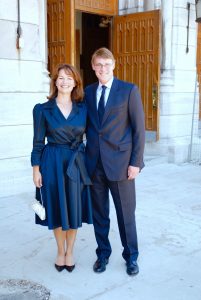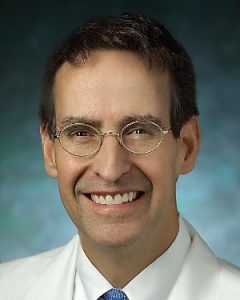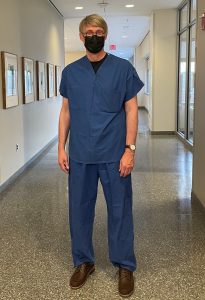
It was a summer evening back in 2021, and James and Laura Schwinn were relaxing after a weekend in New York City and hiking and kayaking near their home in Howard County, Maryland. Suddenly James experienced tremendous chills and a fever that gyrated from 103 degrees to normal, only to spike again. He went to the emergency room and then to a hematologist, who, after seeing blood results, told James he had to return immediately to the hospital. A bacterial infection had found its way to his heart, damaging the mitral valve.
“Mitral valve disease occurs when the valves in the upper heart chamber don’t open or close properly. This can cause blood to flow backward out of the heart or can restrict blood to the main pumping chamber of the heart,” James Gammie, MD, the James T. Dresher, Sr. Professor in Cardiac Surgery and cardiac surgeon-in chief for the Johns Hopkins Health System explains. He performed lifesaving surgery on James, who had been transferred to Johns Hopkins Hospital, to repair the valve.

Today, James walks four miles a day, and he and Laura are back to doing other outdoor activities they have always enjoyed. Grateful for the treatment and care James received throughout Johns Hopkins Medicine, the couple made an outright gift to the Division of Cardiac Surgery and a commitment to support its future through their estate plan. “We hope we advance the already good work they’re doing through our gifts,” Laura says.
In conversations with Gammie, Laura and James learned about his research into less invasive procedures for mitral valve repair and the need for more experts like him in the field — two areas the couple’s giving will address with the long-term goal of expanding access to cardiac care.
“We realized that we can make an estate investment that enables further research in technology and productivity,” James says. “If we can reduce the invasiveness of the procedures, reduce the time the procedures take, and shorten the length of time in the hospitals, we can make our cardiac surgeons more productive. And we can expand the reach of our health care system for many people who need this type of critical care.”
James didn’t go into surgery immediately when he arrived at Johns Hopkins Hospital. He found comfort in his jazz playlist and a binder of information about his pending surgery provided by his care team, something that Laura also appreciated.
“I could go through it for pre-care, what I should expect on the day, and then post-care. It was really well put together, plus videos so that we knew the procedure,” she says, adding the care team gave her time to get to the hospital when the schedule opened sooner than anticipated for James’ surgery. “It was just another element of thoughtfulness.”

Laura and James were as impressed with the attention they received post-surgery on the cardiac floor. “The culture of care made it easy for me to focus on recovery,” James says.
Jazz legends Chet Baker and Art Pepper were a source of comfort, too, and he enjoyed sharing his vast music selection with his clinicians and caretakers.
“They saw you as people, not patients, and there’s a real difference between those two,” Laura says. “They were coming to James to learn more about his music because that was important to him. That also transferred to me. Everyone asked about my well-being.”
James gained even more insight into cardiac care during a recent visit to Johns Hopkins where he had the opportunity to observe Gammie performing mitral valve repair surgery. “It’s not easy to reach the mitral valve,” James says, reinforcing the need for innovative technology to advance the procedure. “Dr. Gammie was explaining various parts as he went through the process. The calm in the operating room and the clarity and level of communication across all of those performing their part was amazing.”
James and Laura moved to Howard County three years ago after many years of working and living abroad and in the U.S. Laura now heads up a chemical company in the county, and James consults with nonprofit organizations following his career in debt capital markets. They plan to settle in Howard County for the long term, enjoying the activities the area offers and engaging with their community, including Johns Hopkins. James continues to see an infectious disease specialist at Hopkins, since contracting a bacteria in his blood is unusual. But the relationship goes beyond that.
“I really like the connection that Hopkins has to both the global community and the local community,” James says. “I don’t think you can say that about all research universities of that caliber. To me and Laura, who now live in that community, that’s important to us.”
Topics: Faculty and Staff, Friends of Johns Hopkins Medicine, Heart and Vascular Institute, Fuel Discovery